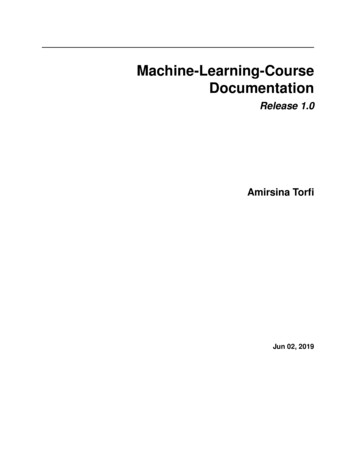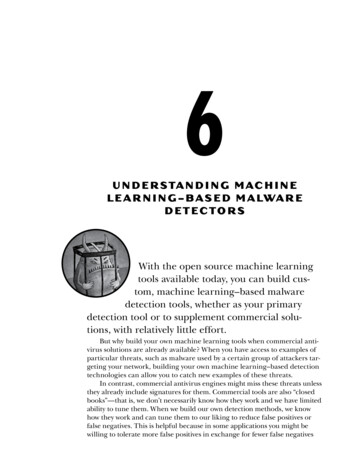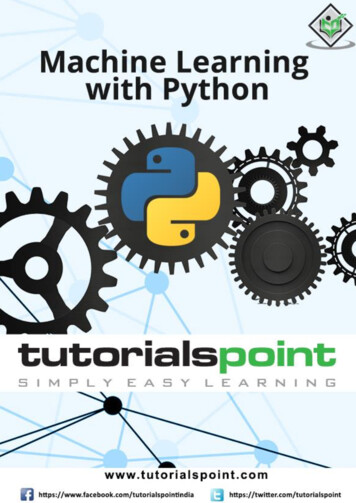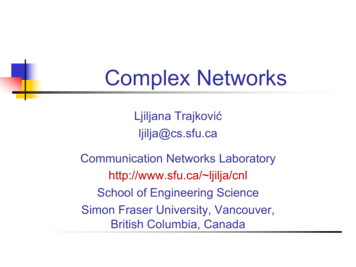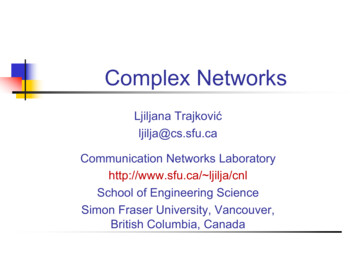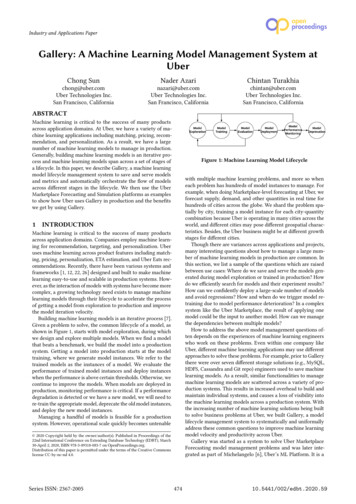
Transcription
Industry and Applications PaperGallery: A Machine Learning Model Management System atUberChong Sunchong@uber.comUber Technologies Inc.San Francisco, CaliforniaNader Azarinazari@uber.comUber Technologies Inc.San Francisco, CaliforniaChintan Turakhiachintan@uber.comUber Technologies Inc.San Francisco, CaliforniaABSTRACTMachine learning is critical to the success of many productsacross application domains. At Uber, we have a variety of machine learning applications including matching, pricing, recommendation, and personalization. As a result, we have a largenumber of machine learning models to manage in production.Generally, building machine learning models is an iterative process and machine learning models span across a set of stages ofa lifecycle. In this paper, we describe Gallery, a machine learningmodel lifecycle management system to save and serve modelsand metrics and automatically orchestrate the ow of modelsacross di erent stages in the lifecycle. We then use the UberMarketplace Forecasting and Simulation platforms as examplesto show how Uber uses Gallery in production and the bene tswe get by using Gallery.1Figure 1: Machine Learning Model Lifecyclewith multiple machine learning problems, and more so wheneach problem has hundreds of model instances to manage. Forexample, when doing Marketplace-level forecasting at Uber, weforecast supply, demand, and other quantities in real time forhundreds of cities across the globe. We shard the problem spatially by city, training a model instance for each city-quantitycombination because Uber is operating in many cities across theworld, and di erent cities may pose di erent geospatial characteristics. Besides, the Uber business might be at di erent growthstages for di erent cities.Though there are variances across applications and projects,many interesting questions about how to manage a large number of machine learning models in production are common. Inthis section, we list a sample of the questions which are raisedbetween use cases: Where do we save and serve the models generated during model exploration or trained in production? Howdo we e ciently search for models and their experiment results?How can we con dently deploy a large-scale number of modelsand avoid regressions? How and when do we trigger model retraining due to model performance deterioration? In a complexsystem like the Uber Marketplace, the result of applying onemodel could be the input to another model. How can we managethe dependencies between multiple models?How to address the above model management questions often depends on the experiences of machine learning engineerswho work on these problems. Even within one company likeUber, di erent machine learning applications may use di erentapproaches to solve these problems. For example, prior to Gallerythere were over seven di erent storage solutions (e.g., MySQL,HDFS, Cassandra and Git repo) engineers used to save machinelearning models. As a result, similar functionalities to managemachine learning models are scattered across a variety of production systems. This results in increased overhead to build andmaintain individual systems, and causes a loss of visibility intothe machine learning models across a production system. Withthe increasing number of machine learning solutions being builtto solve business problems at Uber, we built Gallery, a modellifecycle management system to systematically and uniformallyaddress these common questions to improve machine learningmodel velocity and productivity across Uber.Gallery was started as a system to solve Uber MarketplaceForecasting model management problems and was later integrated as part of Michelangelo [6], Uber’s ML Platform. It is aINTRODUCTIONMachine learning is critical to the success of many productsacross application domains. Companies employ machine learning for recommendation, targeting, and personalization. Uberuses machine learning across product features including matching, pricing, personalization, ETA estimation, and Uber Eats recommendations. Recently, there have been various systems andframeworks [1, 12, 22, 26] designed and built to make machinelearning easy-to-use and scalable in production systems. However, as the interaction of models with systems have become morecomplex, a growing technology need exists to manage machinelearning models through their lifecycle to accelerate the processof getting a model from exploration to production and improvethe model iteration velocity.Building machine learning models is an iterative process [7].Given a problem to solve, the common lifecycle of a model, asshown in Figure 1, starts with model exploration, during whichwe design and explore multiple models. When we nd a modelthat beats a benchmark, we build the model into a productionsystem. Getting a model into production starts at the modeltraining, where we generate model instances. We refer to thetrained models as the instances of a model. We evaluate theperformance of trained model instances and deploy instanceswhen the performance is above certain thresholds. Otherwise, wecontinue to improve the models. When models are deployed inproduction, monitoring performance is critical. If a performancedegradation is detected or we have a new model, we will need tore-train the appropriate model, deprecate the old model instances,and deploy the new model instances.Managing a handful of models is feasible for a productionsystem. However, operational scale quickly becomes untenable 2020 Copyright held by the owner/author(s). Published in Proceedings of the22nd International Conference on Extending Database Technology (EDBT), March30-April 2, 2020, ISBN 978-3-89318-083-7 on OpenProceedings.org.Distribution of this paper is permitted under the terms of the Creative Commonslicense CC-by-nc-nd 4.0.Series ISSN: 2367-200547410.5441/002/edbt.2020.59
3system designed to manage machine learning models by providing functions for model saving, searching, serving, performancemonitoring, and orchestration across di erent stages of the modeldevelopment lifecycle.Overall, the major contributions in this paper are as follows: A comprehensive analysis of the problems we addressedat Uber in order to manage machine learning models in alarge-scale, distributed, microservices-based system. We describe Gallery, a model lifecycle management systemused in production at Uber. We use Uber Marketplace Forecasting and Simulation casestudies to demonstrate how we utilize Gallery to managemachine learning models and the bene ts we have gainedwith Gallery.2THE GALLERY SYSTEMIn the section, we describe Gallery, a model lifecycle managementsystem, built at Uber to solve the aforementioned model management problems. We rst introduce the principles that guideour design. Then, we discuss the overall system architecture,followed by the description of each major system component.3.1Design PrinciplesImmutable. Any machine learning model and model instancegenerated and managed in our system is immutable. Any updateof a model or model instance will result in a new version inproduction. This is critical to guarantee no unexpected behaviorin production, and ensures that all decisions can be traced backto a speci c model version. This builds the foundation for modelperformance observability and debuggability.Model Neutral. Each model is treated as a black box and themodel management system does not interpret the models. In thisway, we can have one system to provide management for thevarying models built for each application, e.g., a deep learningmodel using TensorFlow or PyTorch, or linear regression modelsusing scikit-learn. Users are not blocked from leveraging themodel management system because of their modeling technologychoices.THE MODEL MANAGEMENT PROBLEMWe rst share some machine learning model management context at Uber before we de ne the problem. At Uber, we employnumerous machine learning applications, such as request dispatching, pricing, user growth, and recommendations. Overall,the Uber platform is microservice-based. Application teams buildtheir own services and have di erent requirements for cadenceand latency, implying di erent patterns of running the models.For example, long-term forecasting predicts hourly trips for acity for weeks in the future, while real-time forecasting predictssub-hour demand. As a result, di erent applications might usedi erent languages, modeling techniques, and frameworks forbuilding and serving models.In addition to the variety of applications and models, Uber isoperating in markets across the world that have unique conditions in terms of population, city layout, climate, and populationdensity. As a result, it is common to see machine learning modelstrained separately for di erent markets. We also need to frequently retrain the models when we detect model performancedegradation due to the changing market conditions, and we needto independently trigger the retraining of the models for a city.Often it is not e cient to blindly re-train the models for all thecities, e.g., the training data for real-time demand forecasts caneasily go up as much as terabytes for one city. Instead, we wouldlike to retrain the models periodically if performance evaluationshows the need.To solve the model management issue across heterogenous usecases, a system to manage a variety of machine learning modelsacross di erent frameworks, languages, and usage patterns, frommodel exploration to models deployed in production, is necessary.To be clear, we refer to a machine learning model as an abstractdata transformation which we can use to solve a particular problem or business use case. A model contains the speci cation ofthe input, output, and transformation, e.g., linear regression orrandom forest classi cation and all the corresponding hyperparameters. A model instance consists of a set of coe cients that isa learned representation of a given model on a particular trainingdata set. The terms “model” and “model instance” are commonlyused interchangeably when there is no ambiguity. Accordingly,we de ne the model management problem as: how to consistently and scalably manage a large number of complex modelsand model instances across stages of a model lifecycle.Framework Agnostic. Any framework for model training, evaluation, deployment and serving, e.g., model exploration withPython code manually on a local server or scheduled pipelinesto train models in production, could be seamlessly integratedwith the model management system. With this exibility, we canmanage models from all di erent machine learning projects atdi erent development stages. This lowers the on-boarding costfor new users and provides model management support for awide array of use cases.Automation. With a large number of machine learning modelsand model instances, automatically moving models across different stages in the lifecycle is the key to high scalability andvelocity. Achieving automation requires the management system to have an integrated holistic view of the model work owincluding training, evaluation and deployment.3.2Overall ArchitectureWe show the overall view of the Gallery architecture in Figure 2.Advanced model management is a core component of a machinelearning system as it orchestrates the ow of a model acrossdi erent stages of a lifecycle. For the sake of completeness, we include a generic machine learning system that encompass the basicstages of a machine learning lifecycle and the data infrastructurewe leverage in Gallery for the storage in the architecture. Wedescribe the major components of the Gallery system separatelyin the rest of this section.3.3Data ModelTo manage the lifecycle of a machine learning model, Gallery collects data of models, model instances, and model performance, andthe corresponding metadata information. We present a simpli edversion of the basic Gallery data model in Figure 3.3.3.1 Model. A machine learning model is generally a representation of a transformation from a given input to a givenoutput. We use model metadata to store the basic model information including the model owner, model description (e.g., linear475
Figure 2: Gallery Overall Architectureregression formula or neural network structure), features, hyperparameters, and also the information on how the model can betrained and served.Building machine learning models is always an iterative process through which we generally start with a simple baselinemodel and subsequently improve the model performance by optimizing the model structure, tuning the hyperparameters, orupdating the model features. Therefore, we keep track of theevolution of a model through next and previous pointers in themodel record. In a complex production system, we often haveone model depending on the output of other models. To get aholistic view of the application of machine learning models insuch a system, we also keep track of the model dependency viaupstream and downstream pointers.possible to generate exactly the same model instance due to therandomness introduced in training the models.3.3.3 Model Performance. We track the performance of every model instance for o ine model evaluation and online performance monitoring. When users measure their models eithero ine or online, they can write blobs of evaluation metrics thatpertain to a speci c mode instance. Each metric also has its ownset of metadata to describe the nature of the evaluation. We storemetrics as blobs in order to remain model neutral and framework agnostic. For di erent model evaluations, we can havedi erent metrics, e.g., precision, recall, AUC for classi cationmodels and MSE (Mean Squared Error), MAPE (Mean AbsolutePercentage Error) for regressions models. There are also a lot ofcustomized metrics de ned for application-speci c evaluations.Gallery treats all the metrics the same and the metrics take theform of a structured blob with the basic format of “ metric : value ” pairs.3.3.2 Model Instance. A model instance is a realization of amodel given a set of training data. It consists of the model parameters learnt from the training data and it is used to constructthe model in serving for prediction. To achieve model neutrality,we treat model instances as uninterpreted binary blob data andany updates to the blob will be versioned as a new instance inGallery. As a result, Gallery can not interpret any model andtreats all the models the same. Depending on the types of models,the model instance sizes vary from a few KBs to 10s GBs. Modelblob storage is abstracted from the users, and the blob is savedvia Gallery in distributed data storage systems, e.g., S3 or HDFS.We decouple the storage of the model instance blob with othermodel information. Each model instance has a eld to record themodel instance blob location, which could be a HDFS or S3 path.For a model instance, we use metadata to keep track of thetraining data, training framework, and other con gurations (e.g.,seed for random number generator, number of epochs for traininga deep learning model) we have set for the training to generatethe model instance. Storing all the information about the modelsand model instances allow users of Gallery to closely reproducetheir model instances on demand. Note that it is not always3.3.4 Metadata. As shown in the Figure 3, for Gallery models,model instances, and model performance, we keep a comprehensive set of metadata to identify model ownership, associate eachmodel with its serving context, and link models to their trainingdatasets. With metadata, we can improve the discoverability ofmodels and instances by enabling search over key metadata elds.We record all necessary con gurations, e.g., training code pointer,hyperparameters, and training data location and version, to makemodel instances reproducible. We provide a standard set of metadata elds and naming conventions to unify the characteristicsof a model over a production system.Note that none of the metadata about a model or a modelinstance is generated in Gallery. Users of Gallery need to savethe information to Gallery via APIs within the Gallery server. Anexample of the usage of the Gallery APIs is presented in Section4.1. Gallery simply manages the information and indexes the data476
information about retraining is captured in the model instanceversioning.The versioning approach we took before Gallery is based on semantic versioning using the format of “ major . minor . patch ”.A version example for a demand forecasting model instance is"1.3.10". We adhere to the following basic version updating rules:1) update major versions when model architectures change, e.g.,from linear regression to neural network; 2) update minor versions when features or hyper-parameters change, e.g., adding anew feature, and 3) update patch versions when the model instance is retrained. This approach works well when we have onesimple forecasting model for a handful of cities. However, it isnot manageable when we build and launch multiple forecastingmodel for hundreds of cities. As di erent models might performbetter or worse for di erent cities and the forecasting modelperformance might degrade gradually due to the changes in theUber business, we expect retraining models to improve modelperformance. However we do not want to retrain models for allthe cities if one city performs poorly since that needlessly wastescomputing resources. As a result, we very quickly end up withmultiple model versions for di erent cites in the production system which becomes impossible to manually manage. The basicsemantic versioning schema also loses meaning because citiesare no longer aligned against the same versions.In Gallery, instead of incorporating model semantics into theversions, we adopted a Git style versioning approach and assign aUUID for each model instance. We associate metadata to capturethe model semantics and make it easy to search for. To be speci c,when users create a new model, they declare a base versionid for the model. The base version id is the top-level identi erthat is linked to all its descendent model instances. Typically, abase version id represents some approach to solving a particularproblem (e.g., demand forecasting). Each time a model instanceis trained, a unique identi er is assigned to the trained modeland its metadata tracks which base version id the instance wastrained from. In this way, users can query for speci c modelinstances, or traverse the evolution of their model by followingall instances linked to a given base version id.Figure 4 shows one example of a model and model instance.There are two base model version ids “demand conversion” and“supply cancellation” which represent models for the corresponding business problems. For example, “supply cancellation” hasevolved over four iterations with di erent model instances whichare identi ed by four di erent UUIDs. The model instances aresorted by time and linked to the base model they were trainedfrom.Figure 3: Gallery Basic Data Modelfor querying. As a result, Gallery is model neutral and agnosticto any modeling framework.3.4Model VersioningModel versioning is an approach to uniquely identify a modelor model instance. It is the foundation for model immutability.With versioning, we never override an existing model or modelinstance. Any update to a model or model instance will introducea new version. We keep track of the update history as the lineageof the model or model instance.Versioning of code or artifacts is a basic requirement for anyproduction system. While it is standard to use Git for code versioncontrol, there is no such standard for versioning models or modelinstances. As a result, many users derive their own versioningschemas, like Semantic Versioning [8] and timestamps, whichlead to high maintenance costs due to lack of standandarizationacross users users and applications. Gallery abstracts model versioning away from users, analogous to what Git provides to code,and provides APIs for users to trace model lineages.3.4.2 Dependency Management With Versioning. Besides modeland instance identi cation, versioning is at the core of modeldependency tracking and management. As collaboration growswithin a production system and models become more advanced,there are scenarios where models become dependent on one another. For example, the output of one demand forecasting modelcould be used as a feature for a pricing model. As systems becomemore complex, these types of relationships become very di cultto track. Tracking these relationships is an important prerequisitefor understanding how a model impacts the entire productionenvironment with a holistic view. Users need to be aware of theconsequences of changes in their models, or need to be awarethat changes in their model’s behavior could be due to upstreamdependencies. For example, the performance of Model A couldimprove even though the only change is on its upstream Model3.4.1 Model Instance Versioning. Each model can have one ormultiple model instances. We not only version models, but alsomodel instances. This is because both models and model instanceshave their own notions of change that need to be tracked. Anupdate to a model represents some change to the underlying datatransform such as feature and hyperparameter changes. Typically,these changes happen in response to new approaches for solvinga problem and are usually less frequent than model instanceupdates. Model instance versions represent updates against anexisting model with new training data. In production, periodicretraining is expected as new training data becomes available, and477
Figure 4: Model and Model Instance VersioningFigure 5: Model Dependency GraphFigure 7: Adding New Model Dependencyof Model A can choose to upgrade to the new model version,if they want to include the updated Model B. But, models arenot automatically updated because we would like users to beaware that their model dependencies have changed before theirproduction environment is updated.Figure 7 shows a use case when we add a new model dependency for an existing model. By adding the Model D as thedependency of Model A, we will automatically update modelA’s instance version to 4.2. Accordingly, the downstream Models X and Y will also be updated to instance version 7.2 and 8.2separately.Dependencies between models are established by the userwhen models are rst registered in Gallery. When adding models,Gallery provides operations for the user to add dependent modelsby their uuids. There are also operations exposed for updating orremoving dependencies. Once the dependencies are established,Gallery provides users with APIs to query their model’s upstreamor downstream dependencies and will track model updates acrossdependencies.Figure 6: Model Dependency UpdateB. Without tracking this dependency relationship, we would losetrack of Model B’s impact on the production system.Here, we present one example to show how dependenciesof 5 models are managed by Gallery. In Figure 5, we show adependency graph of ve models. Both Model X and Y depend onModel A and Model A depends on Model B and C. For readability,we use numbers instead of UUIDs to represent the model instanceversions in this example. In Figure 6, we show the case of a modeldependency update. When we update instance of Model B fromversion 2.0 to 2.1, this triggers the version updates for all ModelB’s downstream models including A, X and Y. Considering thatthere is no real change of Model A, X or Y, we automaticallyupdate the model instance version by adding a new model versionto Gallery without changing the production versions. The owner3.5Model StorageThe Gallery model storage layer de nes the interface throughwhich model blobs, metadata, and metrics are stored and retrieved. We have the following model storage requirements:searchability, agnostic, high availability, and low-latency.To satisfy these requirements, we build the Gallery model storage using a hybrid approach. Considering that model metadata478
and metrics are commonly structured data, we use a relationaldatabase, e.g., MySQL, for storing metadata and providing support of exible queries. The MySQL service is supported by theUber infrastructure team to guarantee high availability and deployed cross data centers. Considering the enormity of modelsand model instances, we would not be able to scale up to handlethousands of models and instances if we need to interpret eachmodel. As a result, we treat each model equally and store eachmodel blob as binary data. We leverage Uber’s large data storageservice built on top of S3 and HDFS to store the model blobs toachieve model neutral and framework agnostic design principles.We expect Gallery users to provide their models as serializedbinaries, which are in turn stored in Uber’s large data storageservice. The storage locations are subsequently stored as part ofthe model metadata so that they can be retrieved at serving time.Another bene t of taking this approach to save model blobs isthat it does not have data size constraints, which can be an issuefor large deep learning models. To handle cases of inconsistentdata due to system failures, e.g., MySQL or HDFS write fails, wealways write model blobs rst and only write the model metadataafter the model blobs are successfully stored. If the model blobof a model instance is saved but the metadata fails to save, thenthe model instance will not be available in the system.Model metadata searchability is critical for users managing ahigh volume of models. Users conducting experiments or managing production environments need the ability to easily searchand query models based on key metadata like training dates,model type, and features. Model searchability allows easy tracking of all models in the wild and more e cient analysis andexperimentation over the various models.Brie y, model storage is accessed via a uni ed DAL (dataaccess layer). The model performance metrics are saved andread from MySQL to support exible queries for analysis andmonitoring. When models instance blobs are queried, the request rst goes to MySQL to get the location of the model blob, andthen the model is directly accessed via the storage location. Thecache is updated with the requested blob and then is subsequentlyreturned to the user.3.6Model training performance is generally available as a by-productof model training. Model validation performance is produced byvalidation processes or backtesting and is used to check for modelover tting or as a gauge of whether to deploy a model to production. Model production performance is measured against servedpredictions and re ects the online performance of a model. Theevaluation criteria for each performance metric is entirely upto the user and is con gurable, since di erent models and applications optimize for varying outcomes. We store an object ofmetrics in Gallery and de ne the above metrics as guidelines forusers.With model performance metrics, we can derive various insights about the models in Gallery. The insights can give modelowners a signal on how their model behaves over time, information about their serving environment, and establishes a level oftrust between model owners and model consumers. Here are twoexamples of insights that Gallery can provide: model drift andproduction skew.Model Dri . Model drift refers to the case when the statistical properties of the target variable, which the model is tryingto predict, change over time in unpredictable ways. With realtime platforms, data changes. Accordingly, if the data we use inproduction gradually evolve to have di erent patterns from thedata we use in the training, we may see the model performancedegrade over time. Considering Uber’s rapid growth in manymarkets, this drift can occur and once detected, triggers modelre-training via Gallery rule engine using the new training data.Production Skew. Production skew is the di erence betweenperformance at training time and serving time. Multiple factorscan result in production skew, such as bugs in training or servingimplementation, or discrepancies between training data and datafeeding to model serving. The ability to detect production skewis critical for model performance monitoring.3.7Orchestration Rule EngineAs the number of models and model instances grow in a production system, it becomes increasingly di cult to manuallymanage their various states. Therefore, we designed and built arule engine in Gallery to orchestrate the model work ows. Basedon the model metadata, such as deployment con guration andvarious model performance metrics in Gallery, users can de neconditions and actions in rules to automatically move the modelsacross the stages of the lifecycle, such as model deployment andserving, monitoring and retraining, and deprecation.In the following section, we rst show the basic automationswe need in the model lifecycle stages where the rule engine canhelp. Then, we describe our design of the rule engine system andillustrate how it works with examples.Model Performance and HealthWhen building and maintaining production-grade software systems, it is standard to de ne SLAs with consumers to establishaccountability and trust. Typical SLAs for software systems include availability, latency, and throughput. For machine learningsystems, we also would like to have SLAs on performance. Wede ne model health as a set of metrics and standards for users toadhere to in order to guarantee some level of accountability ofmodels in Gallery.More speci cally, we de ne two categories of metrics to measure the model health. One category of the metrics is on thecompleteness of model information, which consists of metadatafor model reproducibility and model performance. Productionmodels should contain enough metadata to reproduce the modeland annotate the behavior leading to a decision. Di erent modelsmay have di erent performance metrics. In Gallery, we ensurethat the performance of each model is evaluated and sto
Building machine learning models is an iterative process [ 7]. Given a problem to solve, the common lifecycle of a model, as . maintain individual systems, and causes a loss of visibility into the machine learning models across a production system. With . Python code manually on a local server or scheduled pipelines






